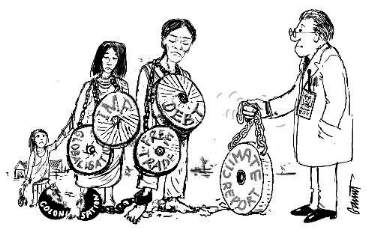Tiempo Climate Cyberlibrary
The Point Seven Percent Solution
- Tiempo archive
- Complete issues
- Selected articles
- Cartoons
- Climate treaty
- Latest news
- Secretariat
- National reports
- IPCC
About the Cyberlibrary
The Tiempo Climate Cyberlibrary was developed by Mick Kelly and Sarah Granich on behalf of the Stockholm Environment Institute and the International Institute for Environment and Development, with sponsorship from the Swedish International Development Cooperation Agency.
While every effort is made to ensure that information on this site, and on other sites that are referenced here, is accurate, no liability for loss or damage resulting from use of this information can be accepted.
  |
Calls for a broadening of control commitments to include developing nations were firmly rebuffed at the Delhi Conference of the Parties to the climate treaty in October 2002. Newswatch editors Mick Kelly and Sarah Granich propose a way forward. |
The emphasis placed on the broadening of emissions control commitments at the Delhi meeting must represent one of the major negotiating disasters of the climate regime. Surely any diplomatic novice would have been aware that putting such a proposal before the conference host, India, represented the height of discourtesy, placing the host nation in the embarrassing position of having to refuse a request. India could hardly be expected to make what would appear a major concession to the domestic audience.
There are great differences between the many nations of the South, but the North-South divide defined by the very different historic responsibility of North and South for the climate problem cannot be ignored.
The climate treaty recognizes this difference in the phrasing of the Annex I commitment to stabilization of emissions by 2000. This commitment is phrased as a demonstration that these developed nations are “taking the lead” in responding to the climate threat (Article 4.2), a demonstration of good faith to those in the South who have little past responsibility.
This demonstration of good faith has not occurred. Of the major industrialized nations, less than one in four has met the carbon stabilization target. And even then, stabilization was often the result of existing circumstances (recession, fuel switching or reliance on non-fossil fuels) rather than any deliberate government policy on climate.
The potential damage done to the Kyoto process is considerable. The alienation of the developing world has played into the hands of the United States’ policy of divide and conquer, creating tension within the G-77/China axis and allowing the United States to cast itself as the defender of the South against the Kyoto bullies. Perhaps more importantly, this error of judgement has set back the initial stage of what was always going to be the most difficult phase of the climate negotiations.
The reality of the global warming problem is that the future growth in emissions in the developing world does represent a very serious threat. In terms of total emissions – though not, of course, per capita emissions – the contribution of the South could well exceed that of the industrialized world by the year 2050. If the rate of global warming is to be kept within acceptable limits, and the need for adaptation constrained to manageable proportions, at some point in the not-too-distant future some level of control on the rate of southern emissions growth is inevitable.
|
|
|
© 2002 Lawrence Moore |
But how can this be achieved without consigning the bulk of the population of the South to a depressed quality of life, if not continuing poverty and deprivation?
One way forward would be to return to that requirement that the northern nations demonstrate that they are “taking the lead,” accept the failure of the stabilization demonstration and link any dialogue on southern commitments to another target that has yet to be met.
At the Earth Summit in 1992, the nations of the North committed themselves to devoting 0.7 per cent of Gross Domestic Product (GDP) to international aid, a target first proposed by the United Nations back in 1970. To date, only Denmark, Luxembourg, The Netherlands, Norway and Sweden have achieved this goal. The industrialized world currently gives about 0.22 per cent of GDP. This is down a third from ten years ago when the commitment was made.
Strengthening resolve to meet the 0.7 per cent target by linking the realization of this goal to formal dialogue on southern emissions constraints would represent a major step forward for both sides, protecting both southern development aspirations and global climate.
The ‘point seven percent solution’ represents a simple and equitable approach to one of the most difficult challenges that the world faces in these opening years of the 21st century.
Further information
Mick Kelly and Sarah Granich, Tiempo, School of
Environmental Sciences, University of East Anglia, Norwich
NR10 4TJ, UK. Fax: +44-1603-507719. Email: tiempo.editorial.gmail.com.
Web: www.tiempocyberclimate.org/newswatch/editors.htm.
Bright Ideas

General Electric plans to cut solar installation costs by half

Project 90 by 2030 supports South African school children and managers reduce their carbon footprint through its Club programme

Bath & North East Somerset Council in the United Kingdom has installed smart LED carriageway lighting that automatically adjusts to light and traffic levels

The United States National Oceanic and Atmospheric Administration and the American Public Gardens Association are mounting an educational exhibit at Longwood Gardens showing the link between temperature and planting zones

The energy-efficient Crowne Plaza Copenhagen Towers hotel is powered by renewable and sustainable sources, including integrated solar photovoltaics and guest-powered bicycles
El Hierro, one of the Canary Islands, plans to generate 80 per cent of its energy from renewable sources

The green roof on the Remarkables Primary School in New Zealand reduces stormwater runoff, provides insulation and doubles as an outdoor classroom

The Weather Info for All project aims to roll out up to five thousand automatic weather observation stations throughout Africa

SolSource turns its own waste heat into electricity or stores it in thermal fabrics, harnessing the sun's energy for cooking and electricity for low-income families

The Wave House uses vegetation for its architectural and environmental qualities, and especially in terms of thermal insulation

The Mbale compost-processing plant in Uganda produces cheaper fertilizer and reduces greenhouse gas emissions

At Casa Grande, Frito-Lay has reduced energy consumption by nearly a fifth since 2006 by, amongst other things, installing a heat recovery system to preheat cooking oil
Updated: May 15th 2015
